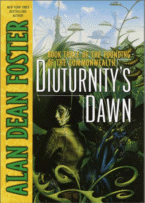

See the parallel lines used for comparison purposes? This one would be expected of a Hivistahm, this nearly straight line for a Lepar. With a long, slim finger she traced patterns on the readout’s screen. How like the Massood, Second-of-Medicine thought. For example, an astonishing increase in cortical electrical activity there was. ”A difficult observation to argue with,” Soliwik muttered. ”As study proceeded and stimuli grew more actively intrusive more atypical reactions we began to note.” Different species react to different stimuli and in differing fashion.” ”Through the usual prescribed stimuli we ran, starting slow and imprecise at first, analyzing and recording as we proceeded. The technicians had managed to remove the mesh from its head. The Human was still asleep, no longer kicking but still wearing a strange expression. Alien but not abnormal sleep pattern.” Nervously she looked over her shoulder at the examination lounge. ”Look here,” she said, speaking through her translator. Delicate fingers made demands of fine switches. Second-of-Medicine took the readout and peered through his eyeshades at scrolling information. Caldaq grabbed the device, called up a preliminary interpretation in Massood as someone placed a funnel-shaped respirator over the interfacer’s snout.

A technician arrived with a small readout. ”Truly truly most truly we do not know.” Second-of-Medicine looked stricken. ”What happened here?” Caldaq’s tone was short, clipped. Blood trickled from one nostril, running the length of her snout. Chief-of-Medicine himself was squatting over her, carefully running a diagnost around her head. Swearing, Caldaq and Soliwik abandoned the observation chamber and rushed to help.īy the time they arrived the technicians had the mesh off the interfacer and were gently lowering her motionless form onto a medical pallet. A Hivistahm caught a foot that sent her tumbling. The specimen reacted with a loud moan and threw the technician aside. One O’o’yan threw himself on the native’s left arm. Others attempted to restrain the interfacer, who was hissing violently as she continued to strike out in all directions. He also won the Ignotus Award (Spain) in 1994 and the Stannik Award (Russia) in 2000.Emerging from the momentary paralysis brought on by what they’d seen, several physician-seconds rushed to the aid of the bleeding, sputtering O’o’yan. His novel Our Lady of the Machine won him the UPC Award (Spain) in 1993. The book Cyber Way won the Southwest Book Award for Fiction in 1990. Splinter of the Mind's Eye, a bestselling novel based on the Star Wars movies, received the Galaxy Award in 1979. Other books include novelizations of science fiction movies and television shows such as Star Trek, The Black Hole, Starman, Star Wars, and the Alien movies.
ALAN DEAN FOSTER BOOKS NEAR HUMAN RACES SERIES
The Tar-Aiym Krang also marked the first appearance of Flinx, a young man with paranormal abilities, who reappears in other books, including Orphan Star, For Love of Mother-Not, and Flinx in Flux.įoster has also written The Damned series and the Spellsinger series, which includes The Hour of the Gate, The Moment of the Magician, The Paths of the Perambulator, and Son of Spellsinger, among others. Several other novels, including the Icerigger trilogy, are also set in the world of the Commonwealth. His first novel, The Tar-Aiym Krang, introduced the Humanx Commonwealth, a galactic alliance between humans and an insectlike race called Thranx.

This interest is carried over to his writing, but with a twist: the new places encountered in his books are likely to be on another planet, and the people may belong to an alien race.įoster began his career as an author when a letter he sent to Arkham Collection was purchased by the editor and published in the magazine in 1968. Foster lives in Arizona with his wife, but he enjoys traveling because it gives him opportunities to meet new people and explore new places and cultures. in Political Science from UCLA in 1968, and a M.F.A.


 0 kommentar(er)
0 kommentar(er)
